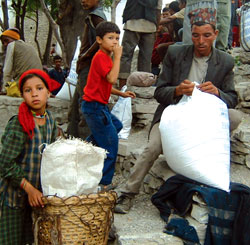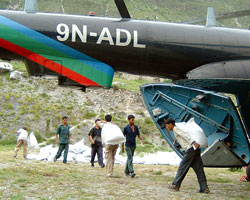|
|
"We harvested in April; that food was finished in May. I went to work in someone's house to earn money and when my husband came back from India, he brought one bag of rice. When that ran out, he went to Kolti and bought two bags. Then we borrowed to buy another bag and it ran out four days ago. If the (emergency) rice hadn't come, I don't know what I would have done."
It's a numbing, repetitive litany of hardship and hunger. In southern Bajura district, more than 500 m above the narrow, mighty Karnali River, villagers like Jasu Dhami are running out of options. The mother of five sits on the dirt floor of her house in Rudigaun, Sapata VDC, nursing her youngest child, and explaining how the family used to grow enough rice, potatoes, barley, and millet to provide most of its annual food needs.
For the rest, a family member would migrate to India during the winter to work as a labourer and earn some money. A few years ago, the already sparse rainfall petered out. Last winter was the driest on record. Lucky households reaped half their usual crop. With less yield, the food gap between harvests widened: last week, Jasu had just finished planting rice, one month late.
Kolti airfield was swarming with people when the food drop helicopter arrived. Villagers stooped to pick up the white bags marked 'A gift from Australia'. After climbing a steep flight of steps, they arranged their loads for the walk home. "We've brought all these little kids here to help carry in the hope that we'll get food...last year it was very bad but this year is worse because of the drought," says Kanta Neupane from Sapata VDC, a day's hike along the narrow trails carved into the steep hills that flank the Karnali.
From these paths, the scene below can be deceiving. Green plots may signal irrigated land, as in the fields near Kolti or, on closer inspection, contain stunted maize or millet that will yield little. In days ahead, the main meal will be emergency operation (EMOP) rice with stinging nettles and for visitors, chicken soup. Many locals say the EMOP rice stopped them leaving their homes in despair.
"Before this program was announced, 95 percent of people were planning to go to India but many have changed their minds. This is very good for the short term but do you have anything for the long term?" asks Birsingh BK at his farm in Sapata ward 2.
People are so hungry here in Bajura, they are completing back-breaking trail-building projects even before the 40-kg sacks of food 'payment' can be delivered. The operation here follows WFP's 'food for work' model, which the agency believes prevents locals from becoming dependent.
In April, the UN World Food Programme started hearing that villagers in pockets of 10 mid- and far-western districts were selling not just their few valuables but also essentials like utensils to raise money for food after their crops had withered. In May, the agency approved an emergency food program, its first ever in Nepal.
"We asked SAPPROS (WFP's NGO partner) to start work only in those areas where rice had been delivered.but most communities went ahead and did all the work before getting any rice, which shows how hungry people really were," said WFP Emergency Program Coordinator Julie Thoulouzan after landing in Kolti last week.
Now WFP faces a bigger task: persuading donors that the pattern in this food deficit region has been upset this year, and that the food gap has become a yawning, dangerous chasm. "We've certainly been vocal about the crisis, but this area has food shortages regularly so we have to work harder to overcome scepticism that this year is different," said WFP Country Director Richard Ragan in Kathmandu.
Out in Rudigaun, just a few hours walk from Kolti, at least some development has occurred. Birsingh explains that an NGO gave him an improved variety of rice seed, which he planted successfully for three or four years-but then it stopped producing.
After a few questions SAPPROS regional chief Ratan Sharma figures out that the farmer should have sown the new variety in only one field, surrounded by fields of the traditional one. A trained farmer would have anticipated the failure.
Earlier, at the foot of the Pilichaur suspension bridge, where the Karnali lapped at its banks like an ocean, Sharma asked men puffing on hookahs what sort of development they wanted. Irrigation and seeds, they promptly answered.
SAPPROS has irrigation projects in other parts of the region "but here would be very expensive because of the remoteness," said Sharma. "We have written many proposals to donors for funding but have got no response."
"What these people really need are development projects, but my god, where do you start?" says an official at one donor agency interested in funding the EMOP, adding, "we are planning to get more serious about the Karnali. But for the cost of helping one person here, you can help two people somewhere else in Nepal."
In July's budget speech the government said, "The absence of a road transportation network is the main reason for the economic backwardness of the Karnali" and surrounding districts. It pledged to finish routes linking Kalikot and Jumla and a \'detailed survey\' of a road connecting Kolti and Bajura headquarters Martadi.
Back in Rudigaon, Jasu Dhami's neighbour Maghi Dhami isn't heartened even by the thought of normal rainfall. "I have so little land since the landslide," she says after opening her grain cupboard to reveal a few utensils but no food. She estimates that the 40 kg bag of rice will feed her ill husband and 10 children for roughly a week. Then she will return to India to earn money carrying sand. "Some days the children eat wild vegetables, some days they sleep without food."
Fearing famine in the far-west, many flee annually. Emergency rice is a stopgap.
Malnourished in Mugu
 "We've lost some (children) already. They couldn't be treated in time. If they could have there's a good chance they would have lived," says Mireille Seneclauze of French NGO Action Contre la faim (Action Against Hunger).
"We've lost some (children) already. They couldn't be treated in time. If they could have there's a good chance they would have lived," says Mireille Seneclauze of French NGO Action Contre la faim (Action Against Hunger).
In February and March the group did an assessment of 10 VDCs in Humla and Mugu, concluding that acute malnutrition rates "were more alarming than expected." In June, it began treating about 200 children, the most serious cases. But since then an unconfirmed number of children have died.
Seneclauze told us that the most affected VDCs are Bhy and Matharpu in Mugu and Humla's Darma and Mimi. She added that from reports she has heard, a similar project might be needed in neighbouring districts such as Bajura and Kalikot.
ActionAid Nepal was so struck by video footage of hungry villagers in Mugu that it funded a small, emergency rice delivery to three VDCs. "We thought why not divert some money from our regular program. It was a spontaneous response," Ganga Dutta Acharya told us.
In the past three weeks, the organisation financed two airlifts to Kotdanda VDC in southern Mugu, from where rice was also taken to neighbouring Hanglo and Sukadhik VDCs. "The situation is worse than the year before, because of lack of rain mostly," says Raju Karki of Mugu's Human Rights and Environment Development Centre, who showed the video to ActionAid.
Karki criticised WFP for not identifying the three VDCs during its assessment in April-May. But WFP staff say that they confirmed the 70 VDCs to get EMOP food only after a consultation that included representatives from the SPA, Maoists and NGOs.
Disastrous math
People targeted: 225,000 in 70 VDCs of Jajarkot, Kalikot, Bajura and Dailekh (phase 1) Humla, Jumla (2) Mugu, Rukum, Rolpa and Dolpa (3)
They receive: 80 kg of rice and 7 kg of fortified flour, half when they begin 20 days of food for work, the remainder when they finish
Already delivered: First half of rations to most families in phase 1 districts
Total budget: $5.4 million
Donated: $365,000 from Australia, $250,000 from the US
Money left: $0
WFP's EMOP debts: 543 metric tonnes of rice borrowed from Nepal Food Corporation, $500,000 from an internal account
|
|
ADVERTISEMENT |






